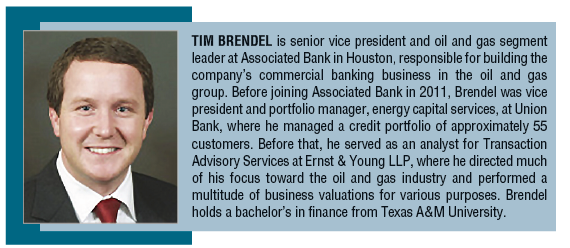
Bank Lending
Traditional Energy Lending Parameters Survive Price Cycles
By Tim Brendel
HOUSTON–The oil and gas industry’s shift in focus from conventional to unconventional resource plays has created an insatiable need for capital. Developing unconventional resource plays is extremely capital intensive, given their deeper horizons, horizontal drilling, and completion and stimulation needs.
Although unconventional resource plays generally are characterized as having high initial production rates, they also have initial decline rates as high as 25 percent a month, in some cases, before finally leveling over the course of several months. These unique characteristics have made it that much more important for the financial community to partner with quality unconventional resource management teams that are good stewards of capital.
Quality management teams control the aspects of the business that are controllable. They look tirelessly for ways to gain operational efficiencies, not only during a lower commodity-price environment when it is an absolute necessity, but also to establish long-term, sustainable businesses that enjoy increased operating margins when prices improve.
Many of these operational efficiencies revolve around unlocking the most cost-effective recipe for developing unconventional resource plays. Variables include lengths of horizontal laterals and fracturing variables such as appropriate fluids, proppants, completion spacing, etc. Slight tweaks to these variables can make a vast difference to rates of return on capital. Additionally, the industry has turned to gaining further efficiencies through pad drilling.
While all this can create operational efficiency, it also can make a chief financial officer or treasurer (or banker, for that matter) work overtime while a substantial amount of working capital is tied up in this process, waiting for production to come on line. Again, these facts stress the importance of partnering with quality management teams that have a track record of operating successfully in a dynamic industry.
Market Uncertainty
The resurgence of oil and gas production in the United States is the result primarily of the efforts of independent oil and gas producers. Not only have independents pioneered the science of shale gas and tight oil development, but IHS estimates they continue to drill 95 percent of new wells in the United States. By any measure, independent oil and gas producers have been incredibly successful at tapping previously unrecoverable hydrocarbons.
But the vast new supplies of U.S. unconventional production, combined with the Organization of Petroleum Exporting Countries’ decision not to curb its production, have led to concerns about oversupply. The result is that the global oil market is in a perceived imbalance between supply and demand, and not surprisingly, the oversupply fears have created uncertainty.
Nevertheless, the oil and gas industry is evolving as fast as ever, and the business opportunities for U.S. independents remain as plentiful as ever. These facts and the extreme volatility in today’s market may lead one to ask: “How does all this impact banks’ lending requirements and deal structures?”
The simple fact is that not much has changed. Just as it was when popularized in the 1970s, reserve-based lending is still the standard lending model for independent oil and gas companies looking for senior debt financing. When done correctly, it is a lending model that has withstood the test of several commodity price cycles. In general:
- Loans are structured as three- to five-year working capital revolving credit facilities.
- Availability is governed by a borrowing base subject to semiannual determinations.
- Loans are secured by first priority liens on the borrower’s oil and gas reserves.
- Proceeds are used for acquisitions, development, working capital, issuing letters of credit, and other general corporate purposes.
- Financial covenants typically include cash flow leverage, interest coverage, and/or current ratio tests measured quarterly.
An independent’s borrowing base is calculated on proved reserves. Specifically:
- A market assessment of commodity prices is used to develop a price forecast used to estimate future cash flow from the borrower’s proved reserves.
- The present value of the borrower’s proved reserves is calculated, based on estimated future cash flow.
- Risk adjustments are made to the present value of proved, nonproducing reserves.
- A conservative advance rate is applied to derive a conforming borrowing base.
Mitigating Deal Risk
Although we are experiencing an oil- and gas-production renaissance and the commodity market certainly is volatile, senior-lending deal structures and underwriting methodologies have remained largely unchanged over the past several decades because the risks inherent in lending to independent oil and gas producers are still largely the same. Although each deal has its own specific nuances, every deal always has and always will exhibit a number of risks.
The first is commodity price risk, which is partially mitigated by bank price decks and/or commodity price hedges.
Banks generally set a price deck that is conservative, relative to the prevailing commodity price environment, and continuously monitor and make changes to their price decks as necessary. More volatile price periods such as the one experienced over the past few months require more frequent price deck changes.
Commodity hedging has evolved over the past several decades. Borrowers can stabilize prices effectively by entering into hedges with financial counterparties. Granted, many borrowers were hesitant to lock in oil prices long term, given the backwardated forward futures curve prior to the fall of oil prices in mid-2014. But with rare exceptions, borrowers are substantially hedged in 2015 and perhaps into 2016, although their hedging profiles fall substantially thereafter. This is something to keep an eye on longer term, if low commodity prices are sustained.
There also is development risk, which is partially mitigated by calculating the borrowing base using only proved reserves, predominantly attributed to proved, developed, producing reserves. Risk adjustments are made to nonproducing proved reserves to account for the additional risk that these reserves may not be converted to production.
Third is reserve risk, which is partially mitigated by borrowers providing their bank a reserve report prepared by a qualified third-party engineering firm. Banks employ external or internal, highly qualified petroleum engineers to evaluate the assumptions utilized by the reputable third-party engineer who prepares the reserve report.
Management Team
Commodity price risk, development risk and reserve risk all can be mitigated partially by the lending and underwriting requirements discussed. However, there is no substitute for the ultimate mitigation: quality management teams with proven track records.
Associated Bank’s decision to partner with independent oil and gas companies starts and ends with the quality of the management team. The objective is to do business with management teams that have succeeded throughout commodity price cycles and have track records of developing and increasing their oil and gas reserves. Today’s commodity price cycle is not their “first rodeo.”
The United States is experiencing a renaissance in oil and gas production driven primarily by technological advances in developing unconventional resource plays, but the more things change, the more they stay the same. Experienced lenders understand the cyclical and dynamic nature of the oil and gas industry. They realize that at the heart of the industry, the risks largely have not changed over the past several decades; they are identifiable and manageable. When done correctly, this is a lending business that will continue to withstand the test of commodity price cycles.
It also is a hard asset business in which oil and gas reserves are evaluated readily, are highly saleable, and are attractive to substantial capital, which equates to extremely low loan-loss content throughout commodity price cycles. Today’s commodity price cycle may be viewed by quality lenders as an opportunity to earn long-term franchise value by demonstrating their commitment to helping borrowers that help themselves, while continuing to prudently grow their business.
For other great articles about exploration, drilling, completions and production, subscribe to The American Oil & Gas Reporter and bookmark www.aogr.com.















